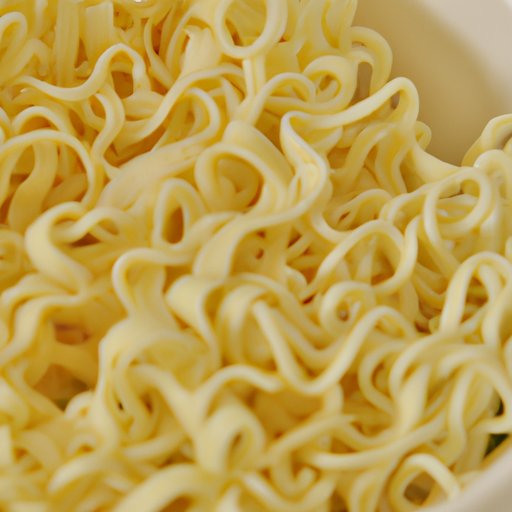Introduction
Ramen noodles have become a staple in many households around the world. Whether you’re a college student looking for a quick and easy meal or a busy parent who needs to feed their family quickly, you’ve likely reached for a package of instant ramen at least once. But is this seemingly innocuous food actually bad for you? This article will explore the nutritional, environmental, and cultural implications of eating ramen noodles.

Analyzing the Nutritional Content of Ramen Noodles
When it comes to analyzing the nutritional content of ramen noodles, there are three main components to consider: macronutrients, micronutrients, and added sugars and sodium.
Macronutrients
Ramen noodles contain a good amount of carbohydrates, with each serving providing approximately 38 grams of carbs. They also contain some protein, with 4-5 grams per serving, as well as a small amount of fat. While these macronutrients can provide some energy and fuel for your body, they don’t offer much else in terms of nutritional value.
Micronutrients
As far as micronutrients go, ramen noodles are lacking. A single serving provides only small amounts of vitamins and minerals, including calcium, iron, and vitamin A. These nutrients are important for maintaining good health, so it’s important to include other sources of them in your diet.
Added Sugars and Sodium
Instant ramen noodles also contain added sugars and sodium, both of which can be detrimental to your health if consumed in excess. According to a study published in the journal Nutrition & Metabolism, “The high sugar and sodium contents of instant noodles may represent a risk factor for metabolic syndrome and its related diseases.”
Examining the Health Benefits and Risks of Eating Ramen Noodles
In addition to examining the nutritional content of ramen noodles, it’s important to look at the potential health benefits and risks associated with consuming them.
Potential Benefits
There are some potential benefits to eating ramen noodles. For example, the carbohydrates in ramen can provide your body with energy. Additionally, the protein in ramen can help build and maintain muscle mass.
Potential Risks
However, there are also some potential risks associated with eating ramen noodles. As previously mentioned, the added sugar and sodium can increase your risk of developing metabolic syndrome and its related diseases. Additionally, the high amount of carbohydrates can lead to an increase in blood sugar levels, which can be dangerous for people with diabetes.

Exploring the Environmental Impact of Ramen Production
In addition to the potential health risks, it’s important to consider the environmental impact of producing and consuming ramen noodles.
Packaging Materials
One of the most significant environmental impacts of ramen production is the packaging materials used. Most ramen noodles come packaged in plastic, which is not biodegradable and can take hundreds of years to decompose. Additionally, the manufacturing process of plastic releases toxic chemicals into the environment.
Energy Use
The production of ramen noodles also requires the use of energy, which can contribute to air pollution and climate change. According to a study published in the journal Environmental Science & Technology, “The energy consumption of instant noodle production is one of the major contributors to global warming and air pollution.”
Water Consumption
Finally, the production of ramen noodles requires a large amount of water. This can put a strain on local water resources and have a negative impact on the environment.

Investigating the Cultural Significance of Ramen Noodles
Ramen noodles have become a part of many different cultures around the world. To understand the cultural significance of ramen, it’s important to look at its origins and popularity in different countries.
Origins of Ramen
Ramen originated in Japan in the late 19th century. Since then, it has been adopted by many other countries and cultures, including China, South Korea, and the United States.
Popularity of Ramen in Different Countries
Today, ramen is popular in many countries around the world. In Japan, it is considered a comfort food and is often served in restaurants. In South Korea, ramen is often eaten as a snack or light meal. In the United States, ramen has become a popular meal among college students due to its low cost and convenience.

Examining How Ramen Noodles Compare to Other Popular Foods
When trying to determine whether or not ramen noodles are bad for you, it’s important to compare them to other popular foods. Here, we’ll look at how ramen noodles compare to other foods in terms of nutrition and cost.
Nutritional Comparison
When it comes to nutrition, ramen noodles are not the best choice. They are high in carbohydrates and sodium, and low in essential vitamins and minerals. Other popular foods, such as whole grains, legumes, and fruits and vegetables, are much better sources of essential nutrients.
Cost Comparison
When it comes to cost, ramen noodles are definitely a winner. A single package of ramen noodles can cost as little as $0.50, making them an affordable option for those on a budget. Other popular foods, such as lean meats and fresh produce, can be much more expensive.
Exploring the Additives Used in Ramen Packaging
It’s also important to consider the additives used in ramen packaging. Many ramen packages contain monosodium glutamate (MSG), which has been linked to several health issues, including headaches and nausea. Additionally, some ramen packages contain preservatives and artificial colors and flavors, which may also be harmful to your health.
Common Ingredients
Some of the most common additives used in ramen packaging include MSG, preservatives, artificial colors, and artificial flavors. While these ingredients may add flavor to the noodles, they can also be detrimental to your health if consumed in excess.
Potential Health Risks
Consuming too much MSG, preservatives, artificial colors, and artificial flavors can increase your risk of developing health problems, such as headaches, nausea, and digestive issues. Additionally, these ingredients have been linked to an increased risk of cancer, so it’s important to be aware of the potential risks associated with consuming them.
Investigating How Ramen Noodles Fit into a Balanced Diet
Ramen noodles can be part of a healthy, balanced diet, but it’s important to consume them in moderation. Here, we’ll explore how to incorporate ramen as part of a healthy diet, as well as some alternatives to ramen.
Incorporating Ramen as Part of a Healthy Diet
When incorporating ramen noodles into your diet, it’s important to pay attention to portion sizes and limit your intake of added sugars and sodium. Additionally, you should make sure to include other sources of essential vitamins and minerals in your diet, such as fruits and vegetables.
Alternatives to Ramen
If you’re looking for an alternative to ramen noodles, there are plenty of options. Some healthier options include whole grain pasta, brown rice, quinoa, and legumes. These foods are all rich in essential vitamins and minerals and can help you achieve a balanced diet.
Conclusion
Ramen noodles can be part of a healthy, balanced diet, but it’s important to practice moderation and be aware of the potential health risks associated with consuming them. Additionally, it’s important to consider the environmental impacts of producing and consuming ramen noodles. Finally, understanding the cultural significance of ramen noodles can help us appreciate the role it plays in many different cultures around the world.
(Note: Is this article not meeting your expectations? Do you have knowledge or insights to share? Unlock new opportunities and expand your reach by joining our authors team. Click Registration to join us and share your expertise with our readers.)
